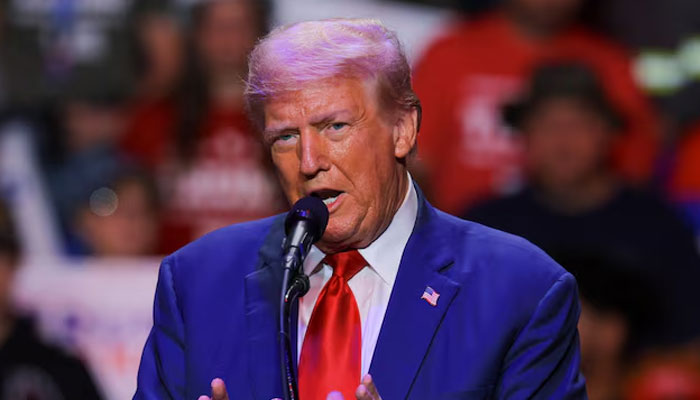
Washington: When President-elect Donald Trump takes office in January, he will inherit a host of national security challenges, including major wars in Ukraine and the Middle East.
What is less discussed are the growing nuclear threats facing the United States, including from Russia, China, and Iran.
Here are the five most pressing nuclear challenges facing Trump:
Russia
Trump will have to manage the most serious tensions with Moscow in more than 60 years, fueled in part by Russian President Vladimir Putin’s threats to use nuclear weapons in his war against Ukraine and his development of exotic new weapons systems.
Putin, who oversees the world’s largest nuclear arsenal, is modernizing his nuclear forces and has rejected talks with Washington on replacing New START, the last US-Russian arms control agreement, when it expires on February 5, 2026.
US officials say Putin remains within the limits set by the treaty despite his 2023 “suspension” of the agreement that obligates Russia and the United States to deploy 1,550 strategic nuclear warheads on 700 intercontinental ballistic missiles, submarines and bombers.
President Joe Biden and Putin agreed to an extension in 2021, but, as written, the agreement cannot be extended any further. Trump opposed the extension in his first term, and instead called for a new treaty that would include China, which rejected the proposal.
Putin noted Washington’s support for Ukraine in rejecting Biden’s calls for unconditional talks on replacing the New START treaty. But both sides say they will abide by the treaty’s limits as long as the other side does.
China
China – which has long had a smaller nuclear arsenal – is building up its strategic nuclear forces.
The Pentagon estimated in 2020 that Beijing’s stockpile of operational nuclear warheads stood at less than 200, and was expected to double by 2030.
That estimate was revised two years later, with the Pentagon saying China would likely have 1,500 nuclear warheads by 2035 if its pace of buildup continued.
Beijing and Washington held their first nuclear risk reduction talks in nearly five years in November 2023.
But China, which adheres to the “no first use” principle, in July officially halted further bilateral discussions on arms control in protest against US arms sales to Taiwan, an island democratically ruled by Beijing.
US
Trump will have to formulate a policy on deterring nuclear threats from Russia and China even as he faces the expiration of the New START treaty.
The Biden administration says the United States may have to deploy more strategic nuclear weapons in the future, and Trump could do that. In his first term, Trump’s nuclear weapons policy called for building new capabilities, reversing decades of US arms control efforts, and he opposed extending the New START Treaty.
But he will face the high costs of modernizing every part of the US nuclear “triad” – intercontinental ballistic missiles, bombers, and submarines – key parts of which are behind schedule and well over budget.
The Arms Control Association expects the costs of this effort, which has grown to include new designs for warheads, missiles, a bomber and a submarine, to exceed $1.5 trillion over the next 30 years.
Experts say that amount is sure to rise, threatening to divert funds needed for conventional U.S. military forces or non-defense programs.
“At some point, we will face a budget-constrained environment,” warned one congressional aide, who spoke on condition of anonymity.
Iran
Iran may decide to build nuclear weapons after exchange of strikes with its arch enemy Israel and Biden’s failure to revive major power talks with Iran on restoring restrictions on its nuclear program.
Washington and its European allies will lose their influence over Tehran when the United Nations Security Council resolution allowing the “return” of international sanctions on Iran expires next October.
The sanctions were lifted in exchange for Iran accepting strict limits on its program under a 2015 agreement aimed at preventing it from developing nuclear weapons.
Trump withdrew the United States from the agreement in 2018, prompting Iran to violate its borders. US officials say the time Iran needs to produce enough highly enriched uranium to make a warhead has now fallen from a year to just weeks or days, although Tehran would need more time to make an actual bomb.
Iran denies US and International Atomic Energy Agency assessments that it halted efforts to build a nuclear warhead in 2003 and has offered to reopen nuclear talks.
But Israeli strikes may push Tehran to revive those efforts. In the wake of the strikes, a senior Iranian official said Tehran may be able to review its self-imposed ban on developing nuclear weapons.
north korea
Tensions with North Korea have increased over Pyongyang’s cooperation in Moscow’s war against Ukraine and the test of a new intercontinental ballistic missile on October 31, highlighting the country’s ability to strike most of the United States with nuclear weapons.
A recent report by the US Defense Intelligence Agency stated that Pyongyang continues to increase its stockpile of materials necessary for its nuclear weapons program.
She also noted that North Korean leader Kim Jong Un has drawn up a defense plan in 2021 that calls for the production of tactical warheads, “lighter nuclear weapons,” and “very large nuclear warheads.”
The Federation of American Scientists estimates that North Korea, which has conducted six underground nuclear explosions since 2006 and more than 100 missile launches since 2022, has enough fissile material to make up to 90 warheads, but has “likely” only amassed 50. .
The Biden administration did not succeed in convincing Kim to revive the denuclearization talks that collapsed after Trump failed in 2019 in the last of the three meetings to persuade the North Korean leader to give up his nuclear weapons.
